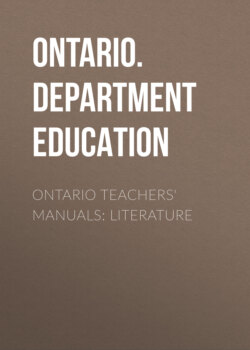Читать книгу Ontario Teachers' Manuals: Literature - Ontario. Department of Education - Страница 18
На сайте Литреса книга снята с продажи.
CORRELATION OF LITERATURE WITH NATURE STUDY, GEOGRAPHY, HISTORY, AND ART
ОглавлениеTable of Contents
Many of the lessons in the Ontario Readers should be preceded by preparatory work in geography, history, or nature study. Poems such as Jacques Cartier, The Charge of the Light Brigade, The Burial of Sir John Moore, and The Armada cannot be fully appreciated unless the historical setting is known. There are famous pictures that will increase the pupil's interest in these poems. In the lessons on art, there are studies of pictures that suggest feelings and thoughts characterized by universality, permanency, and nobility—pictures that stir men to nobler thought and higher aspiration. Often, such pictures are the painter's method of expressing in colours, thoughts that the poet has expressed in words. Lessons such as Dandelions, Bob White, and The Sandpiper require a preliminary acquaintance with certain facts of nature, and therefore should be taken, if possible, when these can be obtained through personal observation by the pupils. Wolfe and Montcalm and Drake's Voyage Around the World demand, in addition to historical facts, certain geographical data. These facts and data should be communicated at some time before the lessons in literature are taken, in order that the latter may not descend into lessons in history, geography, or natural science. The extracts mentioned above are not placed in the Readers to teach certain historical, geographical, or scientific facts. They are placed there, as has been said, primarily because they have some value as literature. Hence the literature lesson should require few digressions, the necessary preparatory work having been done in previous periods.
But while history, geography, nature study, and art frequently assist in the interpretation of a poem or prose selection, these subjects, on the other hand, may be reinforced and strengthened by selections drawn from the fields of literature. The facts of the history lesson will be given an additional attractiveness if the pupil is directed to some well-written biography or drama embodying the same facts, or if the teacher reads or recites to the class some spirited ballad, such as Bonnie Dundee, bearing upon the lesson. The interest in the observations made in nature study will be intensified by reading some nature story written in good literary form.
While these studies may go hand in hand with literature, it is not necessary that they should be always taken on the same day or even in the same week. The literature lesson may be an effective agent in the recall of ideas that have had time to be assimilated from previous nature study, history, or geography lessons. In our enthusiasm for literature we must not make these subjects the mere soil and fertilizers out of which the flowers of poetry will spring. Each of these subjects has its proper sphere, but that teacher misses many golden opportunities who does not frequently take a comprehensive survey of his material in all these studies in order to find the element that will give a unity to all our knowledge and experience. The lessons in the Reader may be taken according to the conditions existing in the class or the inclination of the teacher. By no means is it necessary to follow the order in the book.
